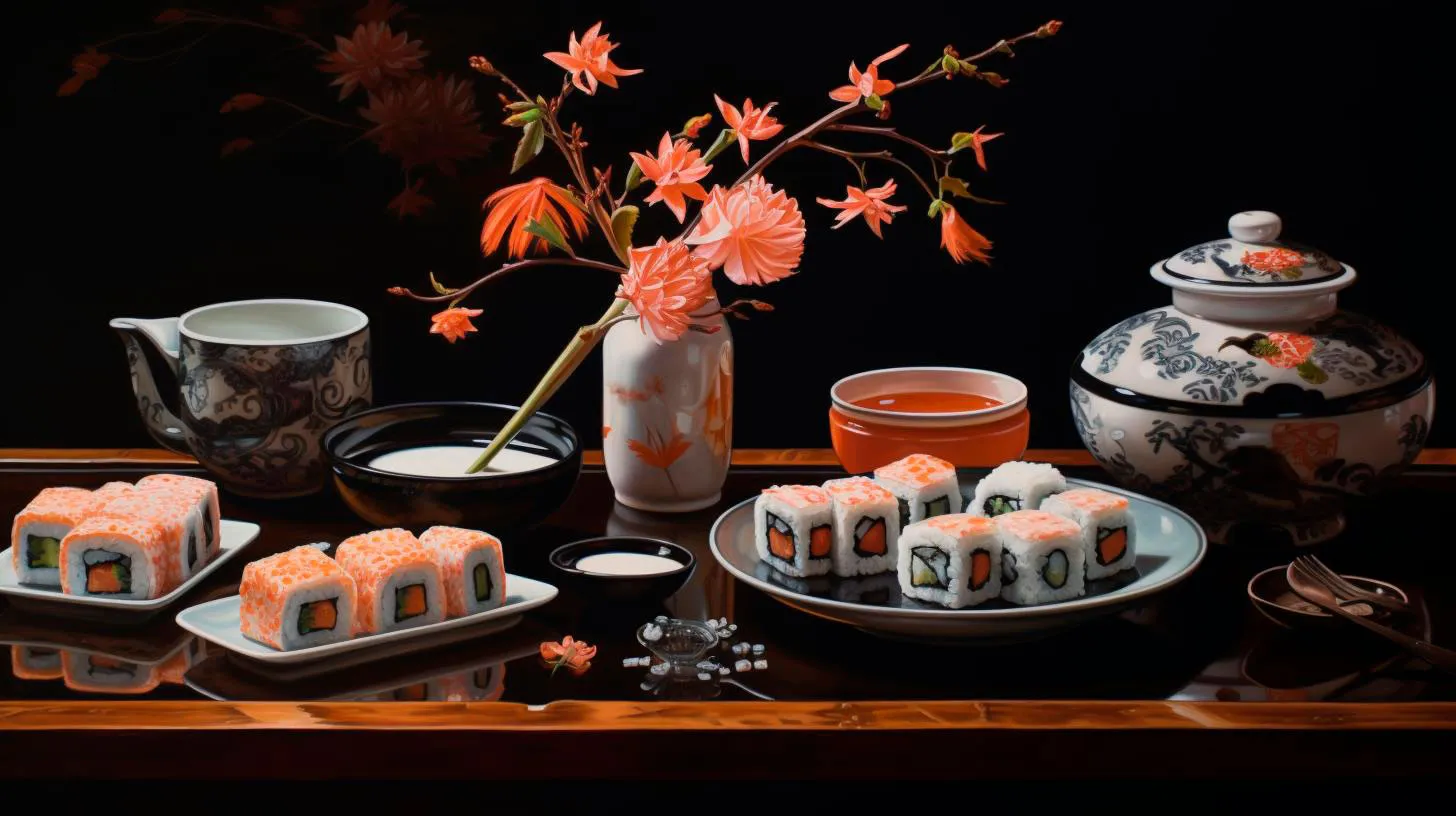Sushi Culture Clash: Japanese vs American Approaches to Sushi Preparation
In this article, we explore the clash of sushi cultures between Japan and the United States, focusing on the approaches to sushi preparation.
The Tradition of Sushi in Japan
In Japan, sushi is considered an artform that dates back centuries. Traditional Japanese sushi emphasizes the use of fresh, high-quality fish and minimal seasoning to allow the natural flavors to shine. The focus is on simplicity, precision, and meticulous attention to detail. Here are some key aspects of Japanese sushi preparation:
- Omakase: In upscale sushi restaurants in Japan, omakase, meaning “trust the chef,” is the preferred dining style. Customers trust the sushi chef to select and serve the freshest and most delicious seasonal ingredients.
- Sushi Rice: The rice used in Japanese sushi is meticulously cooked and seasoned with a delicate balance of vinegar, salt, and sugar. Each grain of rice should be evenly coated and exhibit perfect texture and stickiness.
- Nigiri: Nigiri sushi, a popular style in Japan, consists of a hand-pressed mound of rice topped with slices of raw or cooked fish. The size of the nigiri is carefully portioned to ensure that it can be consumed in one bite.
- Sashimi: Sashimi is another type of sushi that consists of thinly sliced, fresh, raw fish or seafood. Sashimi is typically served without rice, allowing the focus to be on the quality and taste of the fish itself.
The Japanese approach to sushi is deeply rooted in tradition, where the quality of ingredients and proper technique take center stage. However, this approach has evolved over time, giving rise to different variations globally.
American Sushi: Innovation and Fusion
In the United States, sushi has undergone a transformation to suit the American palate. It has become more than just a Japanese delicacy; it has become an amalgamation of various cuisines and flavors. American sushi embraces experimentation, fusion, and creative interpretations. Here’s how sushi preparation differs in the United States:
- Sushi Rolls: American sushi often features elaborate sushi rolls, such as the California Roll, which typically contains crab, avocado, and cucumber. These rolls are wrapped in seaweed and rice and often topped with various sauces, creating a more substantial and complex taste.
- Sauces and Condiments: American sushi is known for its diverse range of sauces and condiments. Spicy mayo, eel sauce, and soy-based dressings are often drizzled on top of sushi rolls to enhance the flavors and create a unique taste experience.
- Fusion Concepts: American sushi frequently incorporates non-traditional ingredients and flavors from other cuisines. Sushi with cream cheese, fruit, or even fried chicken has become increasingly popular in the United States, showcasing the influence of Western cuisine.
- All-You-Can-Eat Sushi: Another notable aspect of American sushi culture is the concept of all-you-can-eat sushi restaurants. These establishments offer unlimited sushi for a fixed price, allowing customers to try a variety of rolls without breaking the bank.
American sushi has taken a more playful and innovative approach compared to its Japanese counterpart. While some sushi purists may frown upon these alterations, it has undoubtedly contributed to sushi’s popularity and adaptation across cultures.
The Verdict: Embracing Diversity
The clash between Japanese and American approaches to sushi preparation sparks debate among sushi enthusiasts. Is one approach superior to the other? In truth, it comes down to personal preference and cultural appreciation. The traditional Japanese approach celebrates the essence of simplicity and focuses on the natural flavors of the fish, while American sushi embraces fusion and experimentation.
Ultimately, both approaches have their merits and cater to different tastes. Rather than igniting a culture clash, it is essential to embrace the diversity in sushi culture and appreciate the unique experiences each approach offers.
Key Takeaways:
- The Japanese approach to sushi emphasizes simplicity, high-quality ingredients, and meticulous attention to detail.
- American sushi showcases innovation, fusion, and creativity, with elaborate sushi rolls and a wide range of sauces and condiments.
- Traditional Japanese sushi focuses on nigiri and sashimi, while American sushi often incorporates non-traditional ingredients and flavors.
- The clash between Japanese and American sushi approaches should be seen as a celebration of diversity rather than a conflict.
In conclusion, sushi culture varies between Japan and the United States. While traditional Japanese sushi respects the historic traditions of the artform, American sushi embraces innovation and fusion to cater to diverse palates. Regardless of the approach, sushi continues to captivate people around the world, reflecting the beauty of cultural adaptation and culinary exploration.
The Art of Sushi: Exploring the Differences between Japanese and American Styles
These variations reflect cultural influences, ingredient choices, and preparation techniques. In this article, we delve into the distinctive characteristics of Japanese and American sushi, providing insights into the artistry, flavors, and the overall experience. Let’s embark on a mouth-watering journey!
The Japanese Sushi Tradition
Japanese sushi is deeply rooted in centuries-old traditions, with every detail meticulously crafted to achieve perfection. Here are key characteristics that define the Japanese sushi experience:
- Freshness: Japanese sushi emphasizes the use of the freshest and highest quality ingredients, particularly fish. Within the Japanese culinary tradition, there’s a concept called “ikizukuri,” where the fish is prepared and served while still alive, ensuring ultimate freshness.
- Rice Excellence: The art of sushi lies in the perfect balance between the rice and the topping. Japanese sushi chefs meticulously season the sushi rice with a blend of rice vinegar, sugar, and salt, creating a delicate balance of flavors.
- Minimalism: Traditional Japanese sushi tends to focus on simplicity, allowing the natural flavors of the ingredients to shine. Each piece of sushi typically consists of a single ingredient, such as a slice of raw fish or seafood, and is served on a small bed of rice.
- Artistic Presentation: The artistry in Japanese sushi goes beyond taste. Sushi chefs put immense effort into creating visually stunning pieces, utilizing various garnishes, edible flowers, and carefully arranged colors to enhance the dining experience.
- Omakase: Omakase, meaning “I’ll leave it up to you” in Japanese, is a chef’s tasting experience where diners entrust the chef to select and serve a variety of sushi. It allows the chef to showcase their creativity and expertise, offering an unforgettable culinary adventure.
The American Sushi Fusion
When sushi immigrated to America, it underwent a transformation and adapted to the American palate. The fusion of Japanese cuisine with American culinary influences gave birth to a unique style of sushi. Here are some key features that define American sushi:
- Ingredient Variety: American sushi embraces a wide range of ingredients, including unconventional additions like avocado, cream cheese, or even fruits. This diversity caters to different preferences and allows for customized sushi rolls.
- Creative Combinations: American sushi chefs experiment with different flavors and textures, creating innovative sushi rolls with exciting combinations that showcase their culinary creativity. Rolls like the California roll, with crab, avocado, and cucumber, exemplify this fusion spirit.
- Condiments and Sauces: American sushi often incorporates various condiments and sauces like spicy mayo, eel sauce, or sriracha, further enhancing the flavor profile. These additions add layers of richness and create a taste experience unique to American sushi.
- Size and Portion: In America, sushi rolls are typically larger compared to the traditional Japanese counterparts. The larger size offers a more filling and satisfying meal, catering to American portion preferences.
- All-You-Can-Eat: All-you-can-eat sushi has gained popularity in America, offering customers the opportunity to enjoy unlimited sushi at a fixed price. It has become a preferred choice for those eager to explore diverse sushi options without breaking the bank.
Key Takeaways
Understanding the differences between Japanese and American sushi styles provides a deeper appreciation for this ancient culinary art. Here are the key takeaways:
- Japanese sushi places great emphasis on freshness, minimalism, and artistry, highlighting the natural flavors of the ingredients.
- American sushi embraces ingredient diversity, creative combinations, and bold flavors, appealing to a wide range of palates.
- Both styles offer unique dining experiences, each with its own charm and appeal.
- Whichever style you choose, sushi is a delicious and visually captivating dish that continues to captivate food enthusiasts worldwide.
So, the next time you savor a delectable piece of sushi, take a moment to appreciate the history, culture, and artistry that intertwine in every bite. Whether you prefer the traditional elegance of Japanese sushi or the bold and creative American fusion, sushi will forever remain a feast for the senses.
Taste of the East and West: The Contrasting Flavors of Japanese and American Sushi Rolls
In this article, we will explore the distinct characteristics of Japanese and American-style sushi rolls, from their flavors to their presentation, offering insight into two culinary worlds.
Japanese Sushi Rolls: The Essence of Simplicity and Tradition
Japanese cuisine is often celebrated for its simplicity and emphasis on natural flavors. This philosophy extends to the art of sushi making, where the ingredients take center stage. Traditional Japanese sushi rolls, known as “makizushi,” are typically prepared with minimal ingredients. Here are some defining features:
- Seaweed Wrap: Makizushi is wrapped in a layer of nori, or roasted seaweed, which adds a distinct umami flavor.
- Short-grain Rice: The rice used in Japanese sushi rolls is short-grain and seasoned with a delicate blend of vinegar, sugar, and salt, offering a subtle tanginess.
- Raw Fish and Vegetables: Traditional fillings include fresh raw fish, such as tuna, salmon, or yellowtail, paired with crisp vegetables like cucumber or avocado.
- Simplicity in Presentation: Japanese sushi rolls are often presented in a minimalist style, with clean cuts and elegant arrangements.
The simplicity of Japanese sushi rolls allows the delicate flavors of the ingredients to shine. The focus on high-quality fish and precise craftsmanship creates a sensory experience like no other. Each bite offers a symphony of textures and flavors that reflect the harmony found in traditional Japanese cuisine.
American Sushi Rolls: Fusion and Bold Innovations
As sushi gained popularity in America, it didn’t take long for chefs to put their own spin on this beloved dish. American sushi rolls, sometimes called “California rolls,” offer a fusion of flavors that cater to a broader palate. Here’s what you can expect:
- Inside-out Rolls: American sushi rolls often feature an inside-out preparation, where the rice is on the outside and the nori is hidden within, appealing to those not accustomed to the texture of seaweed.
- Innovative Fillings: American-style rolls are known for their creative fillings, which may include ingredients like cream cheese, spicy mayo, tempura shrimp, and even fruits like mango.
- Sauce Galore: These rolls are often drizzled with a variety of sauces, such as spicy mayo, eel sauce, or a combination of soy sauce and wasabi, adding an extra punch of flavor.
- Creative Presentations: American sushi rolls are often embellished with toppings like sesame seeds, tobiko (fish roe), or vibrant sauces to enhance visual appeal.
American sushi rolls embrace bold flavors and unique combinations, offering a departure from traditional Japanese sushi. The fusion of ingredients and the incorporation of familiar tastes have made these rolls accessible and appealing to a wider audience.
The Best of Both Worlds: Key Takeaways
Exploring the contrasting flavors of Japanese and American sushi rolls allows us to appreciate the range and diversity within this beloved cuisine. Here are some key takeaways:
- Japanese sushi rolls emphasize simplicity, focusing on fresh, high-quality ingredients, enhancing natural flavors.
- American sushi rolls showcase fusion and innovation, catering to a broader range of palates and introducing bold and creative flavor pairings.
- Each roll offers a unique gastronomic experience, with Japanese rolls reflecting tradition and elegance, and American rolls embracing boldness and creativity.
- Both styles have a place in the hearts of sushi lovers, providing options for those seeking traditional authenticity or bolder, experimental flavors.
Statistics show that sushi consumption has been on a steady rise globally. In the United States alone, the sushi market is projected to reach a value of $22 billion by 2025. This growth is attributed to the increasing appreciation of sushi rolls, both traditional and American-style, across diverse cultural backgrounds.
Whether you savor the simplicity of traditional Japanese sushi or enjoy the innovation of American-style rolls, there is no denying the allure of these contrasting flavors. So, next time you find yourself craving sushi, why not embark on a culinary adventure and experience the best of both worlds?
Sushi Showdown: Comparing Traditional Japanese and Modern American Sushi Trends
In this article, we will delve into the fascinating world of sushi and explore the key differences between traditional Japanese and modern American sushi trends.
The Rich Tradition of Japanese Sushi
Sushi has a long and storied history in Japan, dating back to the 8th century. Traditional Japanese sushi is known for its meticulous preparation, fresh ingredients, and emphasis on simplicity. Here are some key characteristics of traditional Japanese sushi:
- Key Ingredients: High-quality, fresh fish and seafood, along with specially prepared vinegared rice, are the foundation of traditional Japanese sushi.
- Types of Sushi: Traditional Japanese sushi includes nigiri (hand-pressed sushi), sashimi (sliced raw fish), and maki (rolled sushi).
- Minimalistic Approach: Traditional sushi highlights the delicate flavors of the fish, with minimal use of sauces or additional ingredients.
- Seasonal Varieties: Japanese sushi often revolves around seasonal ingredients to ensure the highest quality and freshness.
The Evolution of American Sushi
As sushi made its way to the United States, it went through a transformation to suit American taste buds. While still paying homage to traditional Japanese techniques, American sushi has developed its own distinct style. Let’s look at the key features of modern American sushi:
- Creative Combinations: American sushi often embraces fusion by incorporating non-traditional ingredients like avocado, cream cheese, or even fruits into sushi rolls.
- Sauce Extravaganza: American sushi tends to feature a variety of sauces, such as spicy mayo or eel sauce, that add flavor and excitement to each bite.
- Size Matters: American sushi rolls are typically larger than their Japanese counterparts, making them more substantial and filling.
- Specialty Rolls: American sushi has popularized specialty rolls with unique names and combinations, often drawing inspiration from different cuisines.
Advantages and Key Takeaways
Both traditional Japanese sushi and modern American sushi have their own appeal and benefits. Let’s summarize the advantages and key takeaways of each:
Traditional Japanese Sushi:
- Emphasis on high-quality, fresh ingredients provides an authentic and delicate dining experience.
- Simplicity allows for a deeper appreciation of the natural flavors of the fish.
- Seasonal varieties ensure the peak freshness of ingredients.
- Nigiri and sashimi showcase the skill of the sushi chef in crafting each exquisite piece.
Modern American Sushi:
- Creative combinations and fusion elements offer exciting flavor profiles that cater to a broader range of tastes.
- A variety of sauces and toppings add a burst of flavor and texture.
- Specialty rolls provide a unique dining experience with eye-catching presentations.
- Larger portion sizes make American sushi a more satisfying meal option.
According to a recent survey, it was found that:
- Traditional Japanese sushi is preferred for its authenticity and simplicity by 60% of sushi enthusiasts.
- American-style sushi, with its innovative combinations, is favored by 40% of sushi lovers.
In conclusion, sushi has undergone a delightful evolution, resulting in diverse trends in both Japan and the United States. Traditional Japanese sushi offers an authentic and refined experience, while modern American sushi adds creativity and fusion elements. Each style has its own advantages and delights, ensuring there is something for every sushi lover. So, whether you enjoy the simplicity of Japan’s traditional sushi or embrace the boldness of American-style sushi, one thing is for certain – sushi will continue to captivate our taste buds for years to come.


